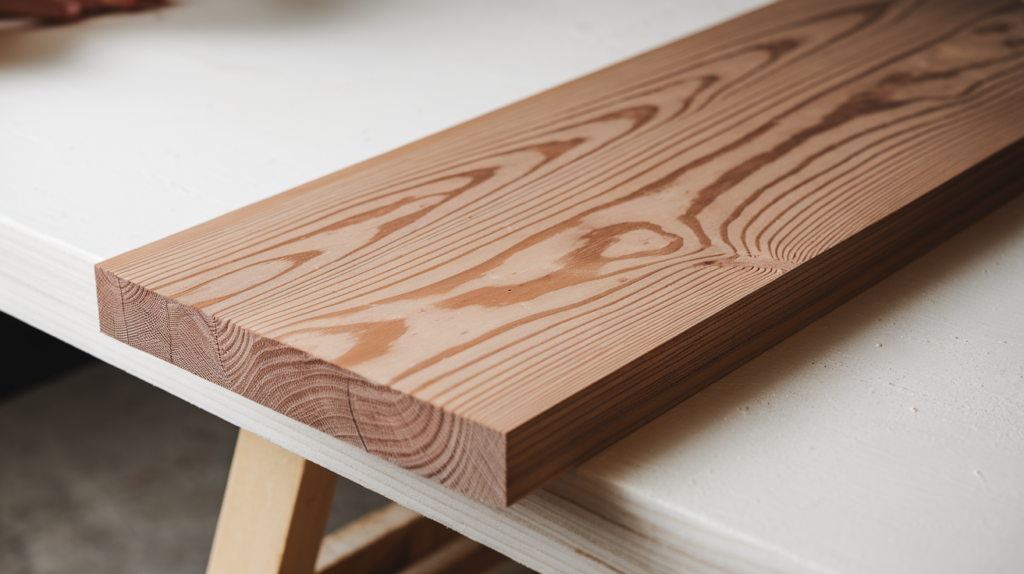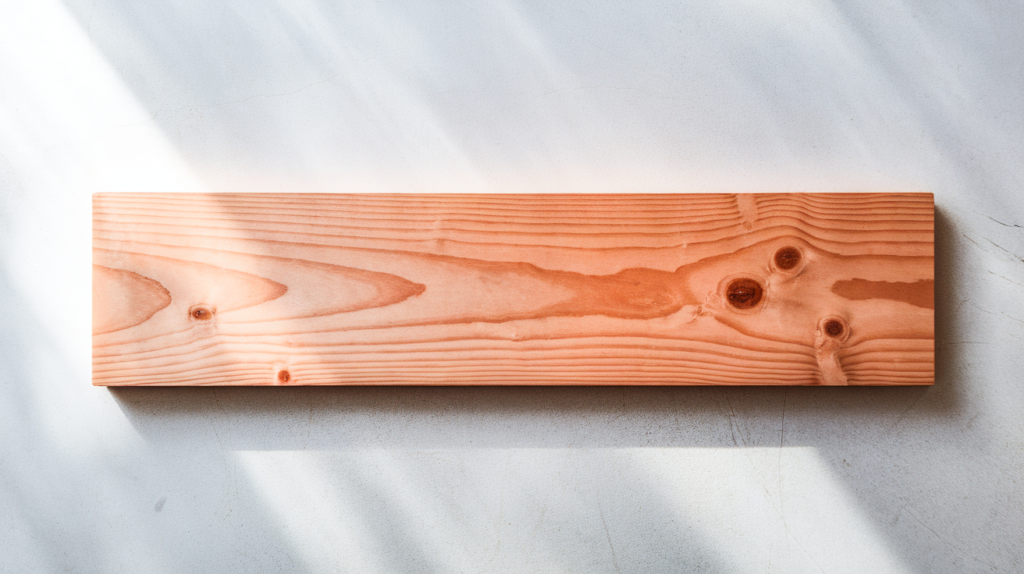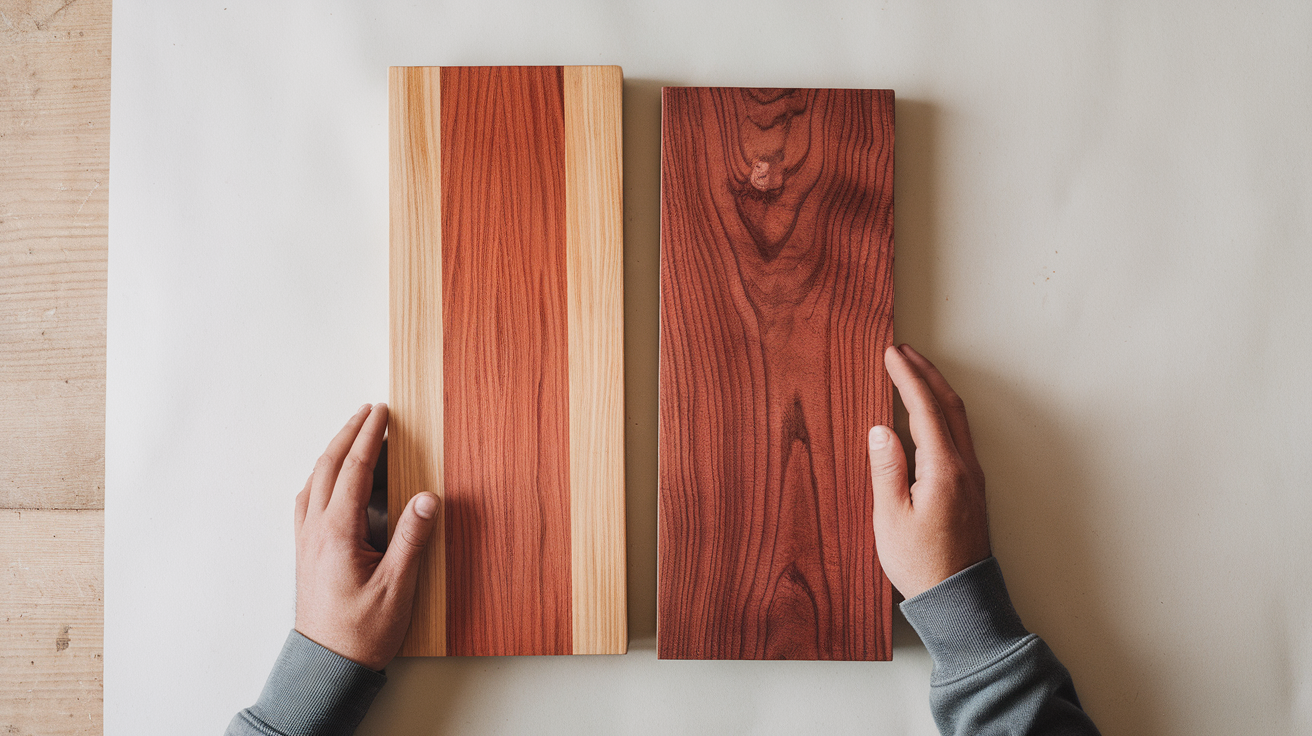Choosing the right wood for your home project might not seem like a big deal at first, but it can really affect how your project turns out and how long it lasts.
Douglas fir and cedar are two of the most common choices people make, and each one has its strengths, depending on their needs.
I’ve worked with both kinds of wood on all types of projects, and I can help you decide which one is best for your needs.
You don’t want to spend money on the wrong material and end up disappointed later.
In this article, I’ll compare Douglas fir and cedar in the areas that matter most – how strong they are, how well they hold up against weather and bugs, how much maintenance they need, what they look like, and how much they cost.
If you’re working on a deck, fence, furniture, or other structural project, you’ll know which wood is best. Let’s start!
Understanding Douglas Fir

Douglas fir is one of the most popular woods used across North America. It comes from tall, straight trees mainly found in the western parts of the continent.
The wood has a light brown or reddish color with a straight, even grain that gives it a clean, smooth look.
What really stands out about Douglas fir is its strength. It’sIt’sder than most softwoods, making it ideal for heavy-duty jobs like framing houses or building decks.
It’sIt’so easy to work with – you can cut, drill, and nail it without much trouble, and it holds screws well when handled carefully.
The only downside is that Douglas fir isn’t naturally resistant to moisture or insects. So, if you’re using it outdoors, it needs proper treatment.
Understanding Cedar

Cedar has been a trusted wood for outdoor projects for generations.
It comes from trees that grow across North America and has a warm, reddish-brown color with a grain that can be straight or slightly wavy.
One of cedar’s features is its fresh, pleasant smell. That scent comes from natural oils in the wood, which help it resist rot, moisture, and insects without needing chemical treatments.
Over time, untreated cedar fades into a beautiful silver-gray color that many people love. It’s also thinner than Douglas fir, which makes it easy to cut and shape, especially for detailed work.
Cedar is also lightweight, so it’s easier to carry and install, perfect if you’re doing a project on your own.
Douglas Fir vs Cedar

Before we compare these two woods point by point, it’s important to understand that neither wood is universally “better” than the other.
The right choice depends entirely on what you’re delivering and where you’re delivering it.
1. Durability and Lifespan
Douglas fir and cedar both have strengths when it comes to durability and lifespan, but they excel in different ways.
Douglas fir is incredibly strong and reliable, especially for projects that need to support weight or handle heavy use.
Cedar, on the other hand, is naturally built to last through the elements, thanks to its oil-rich makeup that resists decay.
| Feature | Douglas Fir | Cedar |
|---|---|---|
| Lifespan (Outdoor Use) | 15–20 years with treatment | 20–30+ years untreated |
| Natural Resistance | Low—requires sealing for moisture and insect protection | High—natural oils resist rot, moisture, and insects |
| Grain & Wear | Dense grain; holds up well in high-traffic or weight-bearing areas | Resists warping and cracking; handles weather changes with ease |
| Maintenance Needed | Regular upkeep is required for outdoor durability | Low maintenance; ages gracefully when left untreated |
In short, if your main concern is holding weight or dealing with high-impact use, Douglas fir is a great pick.
But if you want a wood that can last outdoors with little maintenance, cedar comes out on top.
Choose based on what your project will face most, stress or the weather.
2. Weather and Moisture Resistance
When it comes to weather and moisture resistance, the differences between Douglas fir and cedar are clear.
Douglas fir can hold up in outdoor conditions, but only if it’s properly sealed and maintained.
Without treatment, it tends to absorb moisture, which can lead to warping, swelling, or even rot.
Cedar, on the other hand, has natural oils that act like built-in protection against water damage, making it a top choice for wet or humid environments.
| Feature | Douglas Fir | Cedar |
|---|---|---|
| Moisture Resistance | Low without treatment; absorbs water easily | High natural resistance; repels water |
| Effect in Wet Conditions | Prone to warping, swelling, and rot if not sealed | Maintains shape; rarely warps or cracks |
| Natural Oils | Lacks protective oils; requires sealant | Contains oils that resist water damage |
| Best Use | Dry climates or areas with full protection from moisture | Wet or humid climates with direct rain or snow exposure |
If you’re planning an outdoor project and want to avoid using chemicals, cedar is a better choice. It gives you strong, natural protection with much less maintenance.
3. Insect and Rot Resistance
When comparing insect and rot resistance, cedar stands out as the more durable and natural choice.
Douglas fir, while strong and reliable for many projects, doesn’t have built-in protection against pests or decay.
Without treatment, it’s vulnerable to termites, carpenter ants, and fungal rot.
Cedar, on the other hand, contains natural oils like thujaplicins that repel insects and stop fungi from growing.
| Feature | Douglas Fir | Cedar |
|---|---|---|
| Insect Resistance | Low; needs treatment to prevent pest damage | High, natural oils repel bugs like termites and ants |
| Rot Resistance | Must be treated to avoid fungal decay | Naturally resists rot and fungal growth |
| Chemical Requirements | Requires preservatives for outdoor durability | No need for added chemicals |
| Best Use | Treated structural wood, indoor projects | Outdoor use where natural durability is preferred |
If you want long-lasting wood with natural protection and less chemical use, cedar is a better option for outdoor builds and exposed areas.
4. Maintenance Requirements
When it comes to maintenance requirements, cedar is the easier, more hands-off option. Douglas fir needs consistent care to stay protected outdoors.
Without regular sealing and treatment every 1–2 years, it can fade, crack, or rot much faster than you’d expect.
Cedar, by contrast, handles the elements with less help. You can let it weather naturally to a soft silver-gray or seal it every few years to keep its rich color.
| Feature | Douglas Fir | Cedar |
|---|---|---|
| Sealing Frequency | Every 1–2 years for outdoor protection | Every 2–3 years if you want to keep the original color |
| Natural Weathering | Can deteriorate quickly without treatment | Weathers well and gains a natural silver patina |
| Product Use | Needs preservatives and sealants for moisture and bug resistance | Often requires no added products |
| Overall Upkeep | Higher maintenance over time | Lower maintenance and effort required |
If you’re looking for low-maintenance wood that holds up with less work, cedar is clearly the better long-term choice.
5. Design Appeal
Both Douglas fir and cedar offer unique wood looks. Douglas fir has a clean, uniform appearance that fits well in modern spaces.
Cedar, on the other hand, has a rich and varied look that’s full of natural beauty.
| Feature | Douglas Fir | Cedar |
|---|---|---|
| Grain Pattern | Straight, uniform | More varied; can be straight or wavy |
| Color | Light reddish-brown | Ranges from light amber to deep reddish tones |
| Aging Appearance | Keeps color with stain; minimal change | Develops a silver-gray patina if left untreated |
| Style Suitability | Great for modern and clean designs | Best for rustic, natural, or aged looks |
| Finish Options | Stains evenly and holds color well | Can be sealed or left natural for color shift |
Both woods are beautiful in their own way. Douglas fir gives you a consistent finish that’s easy to customize, while cedar offers more character and natural beauty that evolves over time.
6. Workability
Ease of use matters a lot, especially for DIYers or detailed woodworking projects. Douglas fir is moderately easy to work with, while cedar is soft and simple to cut and shape.
| Feature | Douglas Fir | Cedar |
|---|---|---|
| Ease of Cutting | Fairly easy; straight grain helps | Very easy; soft texture allows smooth cuts |
| Detail Work | Acceptable, though harder wood may limit intricate carving | Excellent for detailed designs and custom shapes |
| Fastener Holding | Holds screws and nails firmly | Softer; may split if fasteners are near edges |
| Tool Impact | May dull blades a bit faster | Gentle on tools |
| Scratch/Dent Risk | Less prone to dents or surface damage | More prone to denting and scratching |
If your project includes fine details or curves, cedar is the easiest material to shape. But for builds that need firm joints and strong fastener grip, Douglas fir holds up better.
7. Strength and Structural Performance
Strength is where Douglas fir really stands out. It’s built for tough jobs and can handle large structural loads. Cedar, while durable for weather, doesn’t hold up as well under pressure.
| Feature | Douglas Fir | Cedar |
|---|---|---|
| Compression Strength | High; used for load-bearing structures | Low; not ideal for heavy structural use |
| Bending Strength | Strong; spans long distances without sagging | Weak; needs extra support for larger spans |
| Weight Support | Excellent for beams, posts, and framing | Not suitable for weight-heavy applications |
| Typical Use | Framing, decking frames, pergola posts | Siding, fences, furniture, trim |
| Strength-to-Weight | One of the best among softwoods | Weaker and lighter overall |
If your project needs solid support and strength, Douglas fir is the clear winner. Cedar works best in non-structural applications where appearance and weather-resistance matter most.
8. Cost and Availability
Cost and availability can make or break a project, especially when working on a tight budget.
Douglas fir is widely available and often much more affordable than cedar. Cedar’s higher price reflects its weather resistance and natural look.
| Feature | Douglas Fir | Cedar |
|---|---|---|
| Price | 30–40% cheaper on average | More expensive, especially for high-grade western red cedar |
| Availability | Easy to find in most hardware and lumber stores | Available, but more limited in some areas |
| Cost-Effectiveness | Great for large projects or bulk builds | Better for detailed or visible areas |
| Maintenance Costs | Higher due to frequent sealing needs | Lower overall with minimal treatment |
| Lifetime Value | Good if maintained regularly | High due to durability and low maintenance |
If you’re watching your spending, Douglas fir gives you more material for your money. But if you want long-term value with less maintenance, cedar may balance out its higher upfront cost.
9. Environmental Impact and Sustainability
Sustainability matters more than ever, and both of these woods have eco-friendly qualities when sourced responsibly.
Douglas fir grows quickly and is often harvested in managed forests. Cedar takes longer to grow, but its natural durability means fewer chemical treatments are needed.
| Feature | Douglas Fir | Cedar |
|---|---|---|
| Growth Rate | Fast-growing; renews quickly | Slower-growing; takes longer to replenish |
| Treatment Requirements | Needs chemical preservatives for outdoor use | Naturally weather-resistant without chemicals |
| Sustainable Sources | Often comes from certified managed forests | Look for FSC-certified cedar for the best sustainability |
| Eco Footprint | Higher if chemically treated | Lower if left untreated |
| Best Use Environmentally | Great for indoor or covered use where treatment isn’t needed | Ideal for outdoor projects with natural protection |
If you want a more eco-friendly choice for outdoor use, cedar gets the edge due to its natural resistance. For indoor use, Douglas fir is also a smart, sustainable option.
Using Douglas Fir and Cedar Together in One Home

You don’t always have to stick with just one type of wood. Many homeowners mix Douglas fir and cedar to get the benefits of both.
I often suggest using Douglas fir for the hidden, structural parts of a project and cedar for the visible and exposed areas.
For example, on a deck, you can use pressure-treated Douglas fir for the support beams underneath and cedar for the top boards and railings.
That way, you get strength where it matters and beauty where it’s seen.
Another good combo is using Douglas fir for framing and cedar for siding or trim.
Just remember that these woods age differently – cedar turns silver-gray, while Douglas fir may darken unevenly, so plan for how that will look.
Conclusion
So, which is better, Douglas fir or cedar? The truth is, there’s no one-size-fits-all answer because it really depends on what your project needs most.
Each wood has its strengths, and picking the right one starts with knowing what you’re building and where it will be used.
Go with Douglas fir if you need strength and support, like for framing or other structural work. It’s great for indoor projects or anything under a roof.
It’s also a solid choice if you’re on a budget and willing to do some upkeep over time. Its harder surface makes it more resistant to dents and wear.
Cedar is better when your project needs to handle rain, sun, or bugs. It looks great on the outside of your home, ages nicely, and requires less maintenance.
It’s also easier to cut and shape for projects that need more detail.
After working with both woods for years, I’ve seen how matching the right wood to the job always leads to better results.
What are you planning to build? Let me know in the comments – I’d love to help you choose!

